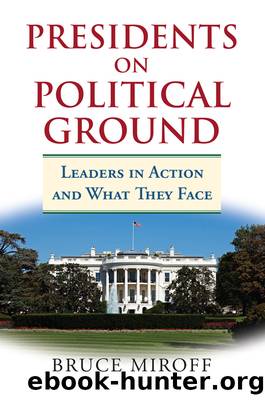Presidents on Political Ground: Leaders in Action and What They Face by Bruce Miroff

Author:Bruce Miroff [Miroff, Bruce]
Language: eng
Format: epub
Tags: National, Political Science, Executive Branch, American Government, Law Enforcement
ISBN: 9780700626489
Google: _8s4swEACAAJ
Goodreads: 36950858
Publisher: University Press of Kansas
Published: 2018-01-19T00:00:00+00:00
OPPORTUNITIES AND CONSTRAINTS IN THE TENDING OF COALITIONS
The distinction between majority-party presidents and minority-party presidents does not capture the full range of historical variability in the relationships between presidents and their partisan coalitions. In the effort to map more systematically this ground for presidential action, a good place to look for guidance is the work of Stephen Skowronek on âpolitical time.â Although Skowronekâs major book on the presidency, The Politics Presidents Make, is typically used for other purposes, I deploy his categories here as a historical guide to the tending of coalitions, drawing on examples from his book and adding some of my own.56
Coming into office in opposition to a discredited and failing political regime, Skowronek writes, a âpresident of reconstructionâ is in the most favorable position to assemble a new coalition. Presidents of this typeâJefferson, Jackson, Lincoln, FDR, and Reaganâreshape the landscape of American politics in a lasting fashion, buoyed by the new majority coalition that assembles behind their person and policies. Their signature policies and their new coalitional forces are intertwined, as with the cases of Lincoln, emancipation, and African American support, or FDR, the Wagner Act, and labor support.
Presidents of reconstruction enjoy leeway in coalitional politics that will not be available to their successors in the regimes they establish. They are uniquely able both to embody and to transcend contradictions among their supporters. The regime founded by FDR united the white South and blacks; the regime founded by Reagan united corporate elites and low-income white workers. The acceptance by regime supporters of such contradictions in the reconstructive president they admire might, one can speculate, have a number of sources. Among these sources might be personal appeal, shared opposition to disliked elements of the old regime, bridging issues that divert contradictory interests from the subjects about which they most sharply disagree, and distributional payoffs that permit each interest to feel that it is a net winner. For example, FDRâs coalition was at its strongest when white southerners and blacks both focused on measures of economic relief, and most jeopardized by issues of civil rights that highlighted their antagonism.
However, the leeway enjoyed by presidents of reconstruction should not be exaggerated. The need to retain the political support of the conservative white South constrained FDR at a number of junctures. Since the white South was vastly more powerful than African Americans in the 1930s, Roosevelt would not touch antilynching legislation, even though his private sympathies were behind it. In constructing the American welfare state, Roosevelt wanted its core programs to be universal in coverage; in compromises to win the votes of southern congressmen, however, African Americans were mostly excluded from them.57 The white South was not the only element of the New Deal coalition that could block FDR from pursuing his preferences. Politically weakened and in declining health as he sought his partyâs nomination for a fourth presidential term in 1944, Roosevelt had to yield to Democratic urban bosses and accept their candidate for the vice presidency, Harry Truman.58
For âpresidents
Download
This site does not store any files on its server. We only index and link to content provided by other sites. Please contact the content providers to delete copyright contents if any and email us, we'll remove relevant links or contents immediately.
The Secret History by Donna Tartt(18857)
The Social Justice Warrior Handbook by Lisa De Pasquale(12143)
Thirteen Reasons Why by Jay Asher(8800)
This Is How You Lose Her by Junot Diaz(6800)
Weapons of Math Destruction by Cathy O'Neil(6151)
Zero to One by Peter Thiel(5691)
Beartown by Fredrik Backman(5603)
The Myth of the Strong Leader by Archie Brown(5429)
The Fire Next Time by James Baldwin(5251)
How Democracies Die by Steven Levitsky & Daniel Ziblatt(5132)
Promise Me, Dad by Joe Biden(5088)
Stone's Rules by Roger Stone(5027)
A Higher Loyalty: Truth, Lies, and Leadership by James Comey(4851)
100 Deadly Skills by Clint Emerson(4845)
Rise and Kill First by Ronen Bergman(4705)
Secrecy World by Jake Bernstein(4652)
The David Icke Guide to the Global Conspiracy (and how to end it) by David Icke(4629)
The Farm by Tom Rob Smith(4442)
The Doomsday Machine by Daniel Ellsberg(4420)
